THE YELLOW JACK HOUSE OF HANCOCK ST (1889)
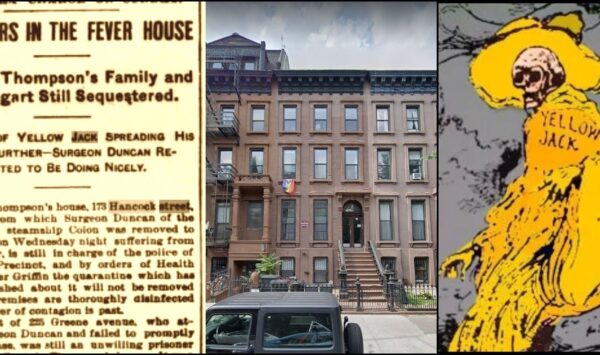
******************************************************************************************************************************** Brownstone Detectives investigates the history of our clients’ homes. The story you are about to read was composed from research conducted in the course of one of those investigations. Do you know the history of YOUR house? ********************************************************************************************************************************In 1889, all of Brooklyn was in a panic. A case of Yellow Fever, known colloquially then as “Yellow Jack,” was identified in June of that year in a brownstone in the Bedford section of Brooklyn. As a result, residents of the house, No. 173 Hancock Street, were quarantined within the building and the brownstone took on the unfortunate appellation, “Yellow Jack House.” The following story comes from The Evening World: “The discovery of a fully developed case of yellow fever in Brooklyn, as first reported in yesterday’s Evening World, has created intense excitement in Brooklyn, particularly in the neighborhood of 173 Hancock street, where the case was found, and ns a result one family moved away this morning to the country and others are preparing to leave. “Dr. R. W. H. Duncan, surgeon of the Pacific Mail steamship Colon, who is the yellow fever patient, has been taken to Swinburne Island, and all the other inmates of the house are kept within doors by a guard of police officers, who ore instructed to keep a close quarantine, not allowing anyone to enter or leave the house. “Dr. Duncan arrived in this city last Friday and was taken to the house of W. H. Thompson, 173 Hancock street, with whose daughter he […]
THE LAST SOLAR ECLIPSE SEEN IN NYC (1925)
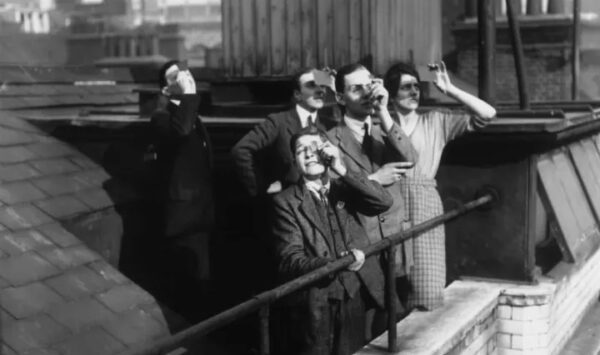
******************************************************************************************************************************** Brownstone Detectives investigates the history of our clients’ homes. The story you are about to read was composed from research conducted in the course of one of those investigations. Do you know the history of YOUR house? ******************************************************************************************************************************** “Not since the coming of the white man to America,” the Brooklyn Daily Eagle specified in January of 1925, “has a total eclipse been visible from … New York City.” The Eagle then went on to describe what to expect from the phenomenon. “A great black disc slowly blotting out the sun. The rush of a gigantic shadow across the earth abruptly turning day into night. The sudden flashing of a streaming pearly halo around the darkened sun. Outbursts of blood red light from the circumfrerence of the sun. Stars shining in the daytime. A sudden chill in the air.” The Eagle‘s words may have sounded overly dramatic, but they were true. And New Yorkers were about to find out just how true. “The most majestic and awe inspiring spectable that man can witness is the total eclipse of the sun. Millions of people will have the opportunity of observing the eclipse to occur on Saturday, Jan. 25. “No total eclipse of the sun has been visible in the northeastern part of the United States since 1806 nor will such an opportunity come again until 2024. Now THAT’s a scientific pedigree! Enjoy the Solar Eclipse! Follow @BrownstoneDetec Share ———————————————————————————————————————– The Brownstone Detectives Brownstone Detectives is an historic property research agency. Our […]
SELLING WHISKEY TO SOLDIERS (1918)
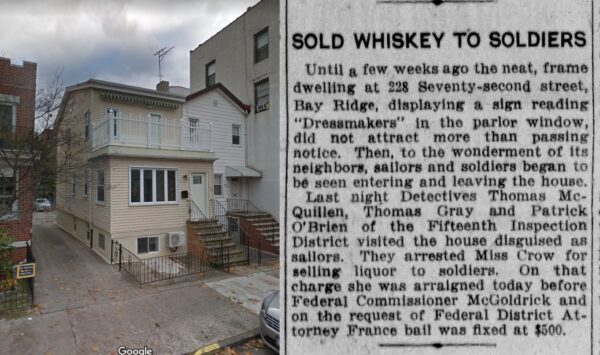
******************************************************************************************************************************** Brownstone Detectives investigates the history of our clients’ homes. The story you are about to read was composed from research conducted in the course of one of those investigations. Do you know the history of YOUR house? ******************************************************************************************************************************** “Until a few weeks ago the neat, frame dwelling at 228 Seventy-second street, Bay Ridge, displaying a sign reading “Dressmakers” in the parlor window did not attract more than a passing notice. Then, to the wonderment of its neighbors, sailors and soldiers began to be seen entering and leaving the house. Last night Detective Thomas McQuillen, Thomas Gray and Patrick O’Brien of the Fifteenth Inspection District visited the house disguised as sailors. They arrested Miss Crow for selling liquor to soldiers. On that charge she was arraigned today before Federal Commissioner McGoldrick and on the request of Federal District Attorney France bail was fixed at $500. Follow @BrownstoneDetec Share ———————————————————————————————————————– The Brownstone Detectives Brownstone Detectives is an historic property research agency. Our mission is to document and save the histories of our clients’ homes. From our research, we produce our celebrated House History Books and House History Reports. Contact us today to begin discovering the history of your home.
SACRIFICED TO A FEED A BRIDGE (1907)
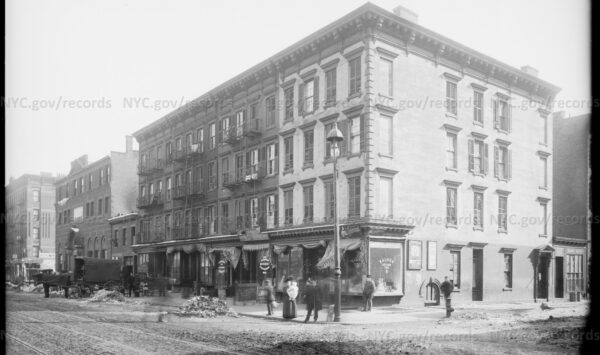
********************************************************************************************************************************Brownstone Detectives investigates the history of our clients’ homes.The story you are about to read was composed from research conducted in the course of one of those investigations.Do you know the history of YOUR house?******************************************************************************************************************************** Most New Yorkers know it when they see it – the Manhattan entrance to the Queensborough Bridge. It’s congested with vehicles, cars, and pedestrians – all just trying to get onto the bridge or around it. Most people, though, don’t know what this area looked like before the bridge was built. In 1907, fortunately for us, someone went around and took pictures of the rows of buildings – mostly wooden – that were doomed to the woodpile, soon to be sacrificed to feed that bridge. In these pictures, you will see life continuing to go on around these buildings. If you look closely, though, you will see something rarely seen in old pictures of New York City life – everyone is preparing for the end. Moving vans abound. Sales are announced. You can even see it in the faces of the subjects: “There is not much time before this is all gone…” To the feint of heart, everything you are about to see – is no more… These are those pics: To see these pictures in their glorious hi-res detail, check out this part of the New York City Department of Records Photographic Collection by clicking HERE. Follow @BrownstoneDetec Share ———————————————————————————————————————– The Brownstone Detectives Brownstone Detectives is an historic property research agency. Our mission is […]
STEP INSIDE A ’70s BROOKLYN BROWNSTONE…
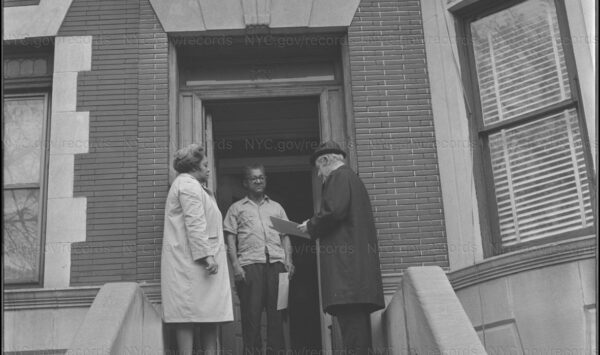
******************************************************************************************************************************** Brownstone Detectives investigates the history of our clients’ homes. The story you are about to read was composed from research conducted in the course of one of those investigations. Do you know the history of YOUR house? ********************************************************************************************************************************In 1970, officials with the New York City Housing and Development Administration (HDA) paid a visit to the owner of No. 23 Virginia Place in Crown Heights. The reason for the visit was assisting citizens with the rehabbing of their homes. The city wanted to get some great shots of their beureuacrats helping everyday folks, and so they took a photographer along with them to show them doing ust jthat. As a result of the public affairs shoot, we have today some great images of what No. 23 Virginia Place looked like in 1970. Enjoy! Follow @BrownstoneDetec Share ———————————————————————————————————————– The Brownstone Detectives Brownstone Detectives is an historic property research agency. Our mission is to document and save the histories of our clients’ homes. From our research, we produce our celebrated House History Books and House History Reports. Contact us today to begin discovering the history of your home. Follow @BrownstoneDetec Share ———————————————————————————————————————– The Brownstone Detectives Brownstone Detectives is an historic property research agency. Our mission is to document and save the histories of our clients’ homes. From our research, we produce our celebrated House History Books and House History Reports. Contact us today to begin discovering the history of your home.
“CINDERELLA OF BERKELEY PLACE” (1971)
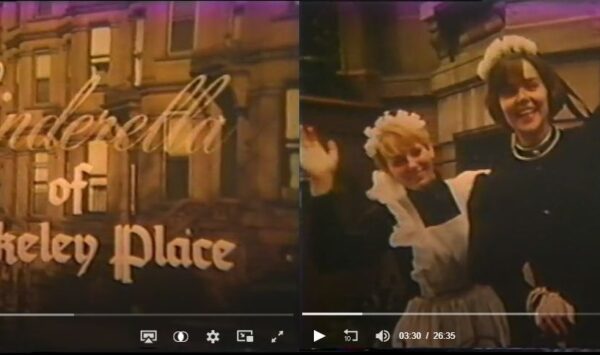
******************************************************************************************************************************** Brownstone Detectives investigates the history of our clients’ homes. The story you are about to read was composed from research conducted in the course of one of those investigations. Do you know the history of YOUR house? ******************************************************************************************************************************** It showed how a brownstone, nicknamed “Cinderella,” in the slums of Park Slope, was about to go through a full-scale renovation. To be sure, the brownstone, No. 211 Berkeley Place, was in truly rough shape – but it had “good bones;” clearly, however, it was the worst house in the best bad neighborhood – and it needed a LOT of work. The brownstone was not being renovated by a couple of young brownstoners, however; it was purchased for renovation by the Brooklyn Union Gas Company, at the behest of local activists. The plan was to show the ease with which brownstones could be renovated with few resources and not a lot of money, allowing owners to live in their own grand brownstones in America’s first suburb. THE ACTIVISTS Everett H. and Evelyn G. Ortner galvanized the historic preservation movement in Brooklyn. In 1963, after living in Brooklyn Heights for the first decade of their marriage, the couple purchased an 1882 four-story brownstone at No. 272 Berkeley Place in the Park Slope neighborhood of Brooklyn. This would be the catalyst for their involvement in the “Brownstone Revival” movement. The Ortners soon became active in a variety of community organizations. They lobbied local banks to provide mortgages to prospective Park Slope home-buyers at […]
HOW TO REMOVE A BROWNSTONE STOOP (1905)
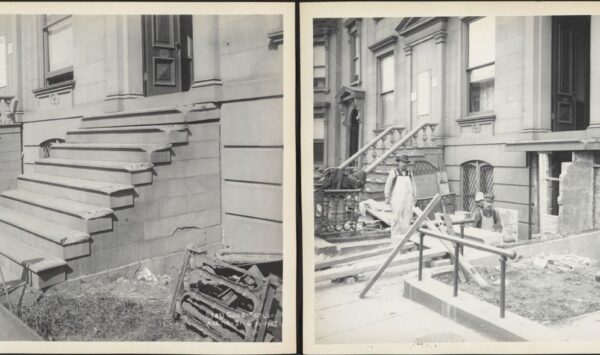
******************************************************************************************************************************** Brownstone Detectives investigates the history of our clients’ homes. The story you are about to read was composed from research conducted in the course of one of those investigations. Do you know the history of YOUR house? ******************************************************************************************************************************** Today, brownstone owners shake their heads in wonder. “Why would anyone intentionally remove the stoop from their own townhouse?” they muse. The stoop, like a timeless portrait’s gilded frame, is a vital element to the design and use of the townhouse. It carries the focus of the viewer into the house itself, just as the stoop physically transports the resident bodily into the house. A brownstone house simply cannot exist without its stoop. Well, like shag carpeting in the 1970s, stoop removal was all the rage in the 1940s. “Remove your stoop and turn your brownstone into apartments,” was the sage advice of contractors hoping to bring their clients’ properties into the 20th century. “Remove your brownstone stoop and add value to your property,” they said. If you didn’t see it happen, though, with your own eyes, you might assume that the destruction was merely accidental. Perhaps a car crashed into the structure and damaged the stoop beyond repair, or time and the elements slowly destroyed the stoop. Well, here, thanks to the New York Historical Society, we have pictures – in all their “glory” – of the “before,” “during” and “after” snapshots of the destruction of one of those august brownstone set of steps. These, documenting the disappearance of a […]
MONKEY SHINES AT No. 72 ST. JAMES PL (1889)
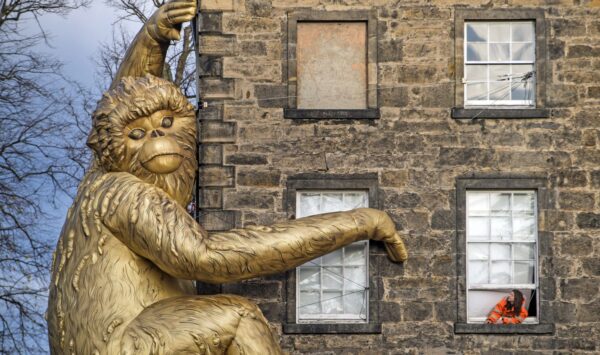
******************************************************************************************************************************** Brownstone Detectives investigates the history of our clients’ homes. The story you are about to read was composed from research conducted in the course of one of those investigations. Do you know the history of YOUR house? ******************************************************************************************************************************** A monkey in Victorian Brooklyn was not the most unusual sight to behold. In fact, the furry little creatures had been roaming the streets of the city since the introduction of the organ grinder. What was unusual, however, was waking up to one that was in “undisputed possession” of your house. ACT I – THE CREATURE APPEARS One Sunday morning in the summer of 1889 at the residence of Mr. William C. Mellins, No. 72 St James Place, Brooklyn, and in that of his next-door neighbor, lawyer William H. Morse, a disturbance of a sort took place. The 2-story and mansard brick residences of Messrs. Morse and Mellins sat, at the time, in a very rustic setting. They were “in the middle of a little block of five buildings, which have vacant lots on either end and a fruit orchard in the rear.” Well, late on a Saturday evening, Mellins happened to be drawn to a sound at his second-story front window. When he went to investigate, he looked toward the sounds, which appeared to be coming from his window. What he saw caused him to wonder if he were seeing things. There returning his gaze was a monkey clinging to his windowsill, looking into the room. Then, as quickly as […]
HOW TO MOVE A ROW OF BROWNSTONES (1905)
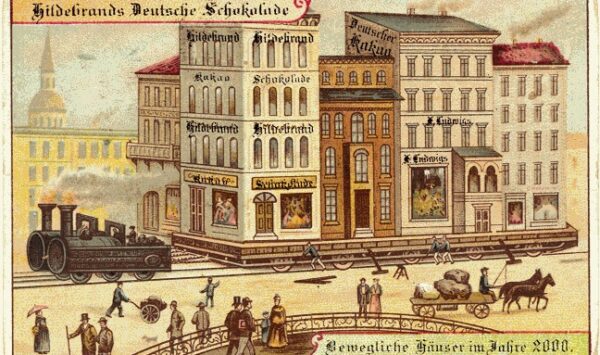
******************************************************************************************************************************** Brownstone Detectives investigates the history of our clients’ homes. The story you are about to read was composed from research conducted in the course of one of those investigations. Do you know the history of YOUR house? ******************************************************************************************************************************** It was called “one of the most unusual examples of housemoving” ever. Up until 1905, no one had ever attempted it. And it was moving two rows of five Brooklyn brownstone houses together, as a row each, one, across the street, and one across a block AND a street. Contractors, experienced in the business, had – to this point – only moved much lighter frame houses, even rows of frame house. But a row of brownstone houses? Impossible! Over a course of several weeks, though, two rows of brownstone houses were jacked up, stabilized – and then rolled away. These same brownstone houses now sit across the street on Jefferson Avenue – as though they had always been there. MAKING WAY FOR THE EXTENSION It all started in the Bedford-Stuyvesant section of Brooklyn, when the State of New York decided it needed more room for an extension to an armory it owned on Sumner Avenue. The armory, bound by Sumner Avenue on the west, Putnam Avenue on the north, and Jefferson avenue on the south, could only expand in one way – into two rows of brownstones. Behind the armory, on Putnam Avenue, sat a row of brownstones from the 1880s, while, on Jefferson Avenue, a more recent vintage of brownstones […]
SNOW DAY ON BERGEN & FLATBUSH (1888)
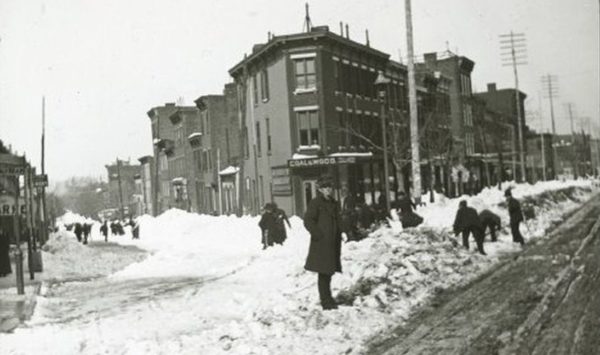
******************************************************************************************************************************** Brownstone Detectives investigates the history of our clients’ homes. The story you are about to read was composed from research conducted in the course of one of those investigations. ******************************************************************************************************************************** Although today was merely a dusting in comparison to the Blizzard of 1888, it gives us an opportunity to look back on what the aftermath of a real snowstorm looked like. In the inset black & white photograph, we see men clearing snow outside of a coal & wood store after the blizzard at the corner of Flatbush Avenue and Bergen Street. We’ve included a Google Maps view of what that corner looks like today. The Coal & Wood shop is now a Gino’s Pizza at 218 Flatbush Avenue. Follow @BrownstoneDetec Share ———————————————————————————————————————– The Brownstone Detectives Brownstone Detectives is a property research agency. Our mission is to research, document, and save the histories of our clients’ historic properties. From this research, we produce our celebrated House History Books. Each book is fully cited, featuring detailed narratives and colorful graphics, and is designed to bring the history of any house to life. Contact us today to begin discovering the history of your home.